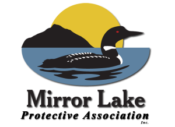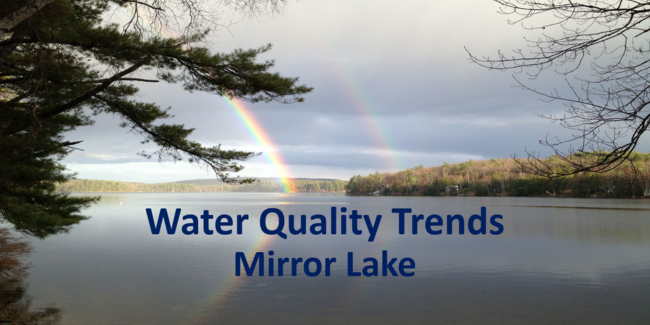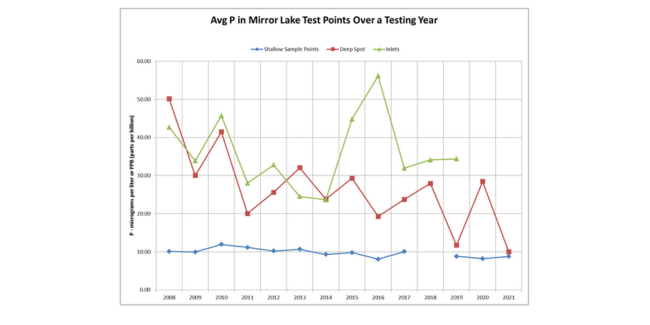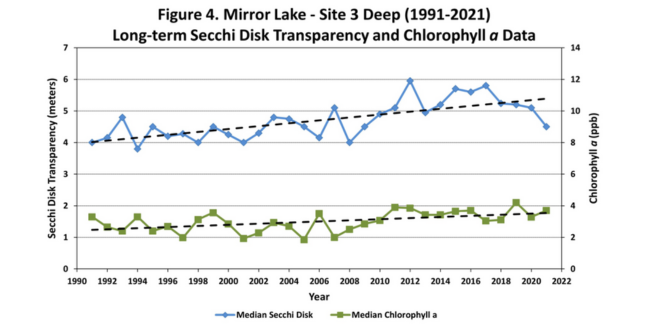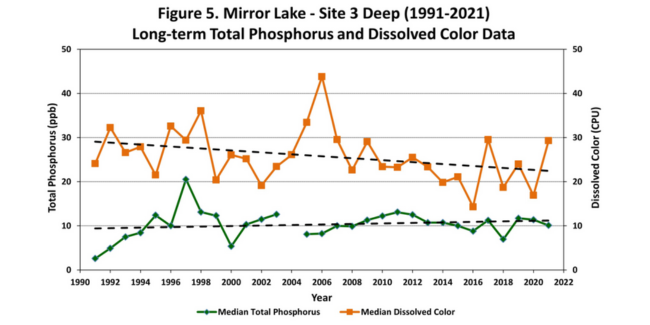
“Good water quality is vital for the health and well-being of all who share Mirror Lake”
NH Clean Water State Revolving Fund (NHCWSRF)
The MLPA Watershed Management Plan
In March 2024, at the Town of Tuftonboro Town Meeting, a warrant article was presented and voted in the affirmative allowing the Town of Tuftonboro to receive and manage a $100,000 forgivable loan on behalf of MLPA for the purpose of recrafting a MLPA Watershed Management Plan II. The first plan, written by Geosyntec in May 2012, has been substantially completed. The new Management Plan focuses on: 1) reassessing the current 2012 Management Plan action items and updating the plan with a Part II; 2) completing a deep analysis of the more than 40 years data collected on the water chemistry of Mirror Lake water; 3) creating a plan to share and implement Best Management Practices (BMPs) throughout the shoreline and watershed; 4) implementation of a detailed shoreline survey involving each property on the lake; 5) creation of new protocols for measuring the chemistry of the lake and its tributaries; 6) other items as deemed necessary by the team managing the funds. As the MLPA Watershed Management Plan is developed and implemented, the MLPA membership will be kept updated regarding progress via emails, letters and the MLPA Annual Meeting.
A NH Statewide Strategy to Combat Cyanobacteria
The statewide plan to address cyanobacteria is now available and has been
posted on the NHDES website. In 2022, legislation was enacted to require the New Hampshire Department of Environmental Services (NHDES) to develop a plan that would prevent the increase of and help control cyanobacteria blooms in water bodies throughout the state.
Recognizing that cyanobacteria blooms cannot be eliminated, the State included strategies to educate, monitor, and evaluate the potential causes of these blooms. This plan marks an important step for the state in outlining specific strategies and actions to address the threat of harmful algal blooms to our freshwater resources.
Each strategy has a list of priority actions associated with it, which can be found in Appendix C. Appendix B lists ideas and suggestions shared by the Cyanobacteria Advisory Committee, and Appendix D. lists a summary of
supplemental actions.
It is worth taking the time to review the plan, its strategies, priorities, and recommended actions. Cyanobacteria blooms are not going away in the near future, and as noted in the Executive Summary, ‘the efforts identified in the plan require policy changes, financial investments, partnerships, research, and education.’
LWA was pleased to participate in the Cyanobacteria Advisory Committee, and will continue in our efforts to reduce nutrient loading to the surface waters in the Winnipesaukee watershed, as well as implementing other
strategies identified in the plan.
Four key strategies were identified as necessary to meet the State’s goals
to prevent the increase of and eventual control of cyanobacteria blooms in
NH’s waterbodies.
The following is excerpted from the plan:
- Develop policies and practices to prevent nutrient inputs.
Significant efforts must be made to reduce nutrient inputs into the state’s surface waters. Control of nutrient loading to surface waters, in particular phosphorus, is best accomplished through state and local policy implementation, stormwater control and watershed and lake management. - Advance outreach and education efforts for individual assessment and action. Respondents to a public outreach survey identified increasing education and training tools as important to making informed decisions about the use of the state’s surface waters with respect to cyanobacteria bloom presence. Such efforts are important to increase general awareness of the public and specific segments of the workforce who have direct contact with the state’s surface waters for recreation and as a drinking water source.
- Enhance monitoring to track frequency, location and duration. Enhancement of cyanobacteria monitoring is needed to track blooms and clearly communicate current conditions to the public. Cyanobacteria blooms vary widely in their duration, severity and distribution.
- Establish policies and procedures specific to surface waters used for public drinking water supplies. There are over 560,000 service points in New Hampshire that provide water to the public that originates from surface waters. To date NHDES is aware of nine surface water sources where cyanobacteria blooms have occurred.
Thank you to the NH Department of Environmental Services (NHDES) for their work and Pat Tarpey the President of the Lake Winnipesaukee Association for this summary.
If you have any questions or comments regarding the plan and its content, please contact David Neils, Chief Aquatic Biologist, and Director of the Jody Connor Limnology Center. He can be reached at 603-271-8865 or david.neils@des.nh.gov.
Water Quality Monitoring
The purpose of water quality monitoring is to learn how to better manage Mirror Lake. MLPA developed a Watershed Management Plan in 2010 to guide Mirror Lake’s management. Typically, a ten-to-fifteen-year plan MLPA is in the process of adding an addendum to the original plan as all but one of the goals has been accomplished. All goals are focused on the ultimate challenge of clean lake water.
The volunteers who collect water samples are providing an excellent service to the lake community and their efforts are applauded! Their collection and analysis of water samples help quantify the lake chemistry trends and determine whether or not our management goals are being achieved. MLPA participates in the two key water monitoring programs available in New Hampshire administered by: 1) the University of New Hampshire Extension Program; and 2) the NH Department of Environmental Services. The UNH program is administered jointly through the UNH Cooperative Extension Natural Resources Program Team and the Center for Freshwater Biology at the University of New Hampshire (UNH) and is called the Lakes Lay Monitoring Program (LLMP) . This volunteer-based, citizen science program provides valuable data on the lakes of New Hampshire. More than 1100 volunteers across the state have participated in this program since the beginning of the monitoring efforts in 1979. The program has spread to 24 states and 11 countries! MLPA has collected regular water samples for the data annually and continues to do so. To view the reports for Mirror Lake and waterbodies around the state, use the LLMP Mapper (use the lake listings on the left of the LLMP site to access Mirror Lake.)
The New Hampshire Department of Environmental Services has a Watershed Management branch as well as a Cyanobacteria Harmful Algal Bloom Program. Established in 1985, the NHDES water monitoring program involves over 800 NH lakes. The sheer volume of work means volunteers are needed to collect water samples via the Volunteer Lake Assessment Program (VLAP.) Volunteer citizens are trained and NHDES biologists are available to assist with VLAP samples. Additionally, two masters level scientists have published theses on the quality of water in Mirror Lake. MLPA developed an early understanding of the threats of invasive species and cyanobacteria and has responded accordingly. Lake reports are published by NHDES annually.
In addition to analyzing Mirror Lake water samples NHDES also tracks cyanobacteria blooms on NH lakes. Mirror Lake had cyanobacteria advisories in 2008; 2014; 2019; 2021 https://www4.des.state.nh.us/onestoppub/TrophicSurveys/Mirror.Tuftonboro.Cyano.html
MLPA water quality is monitored by taking samples from the tributaries feeding Mirror Lake, samples from the Deep Spot, and samples from seven shallow spots.
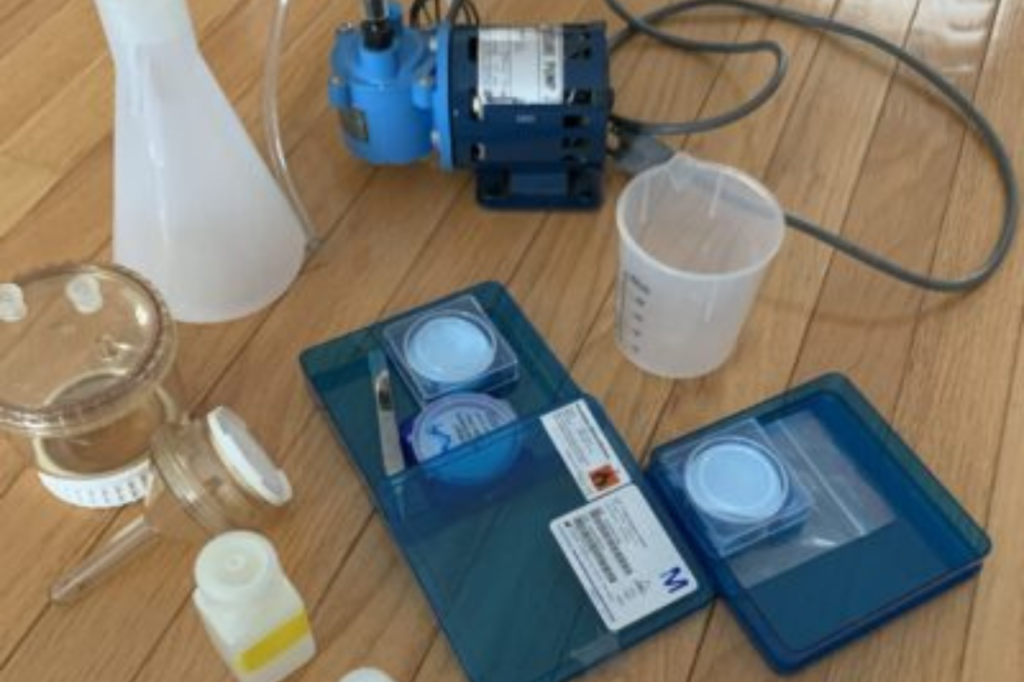
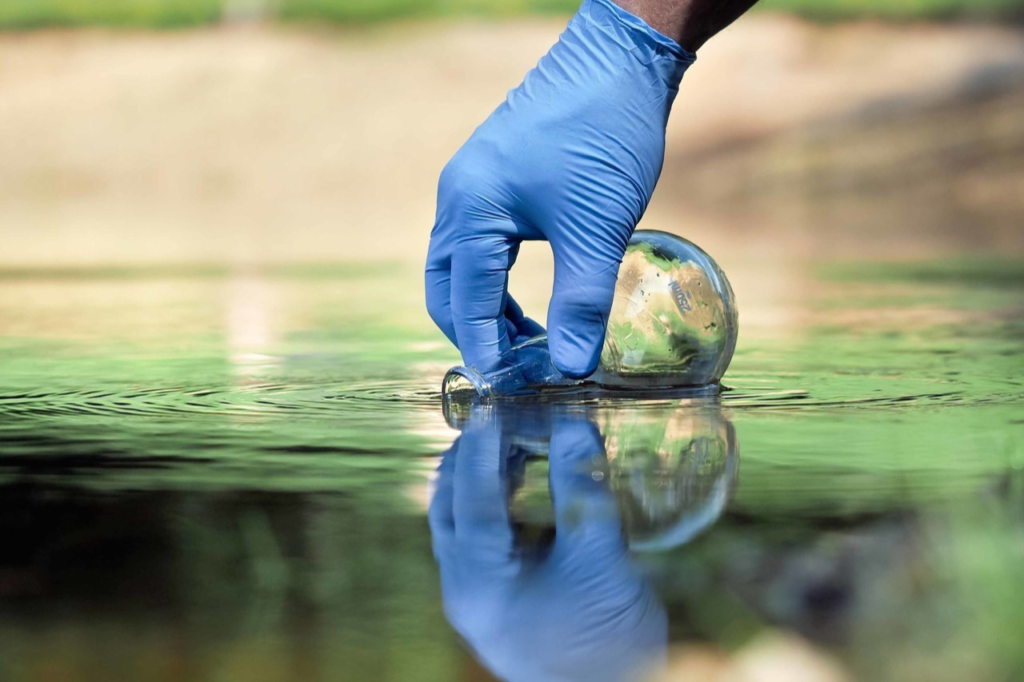
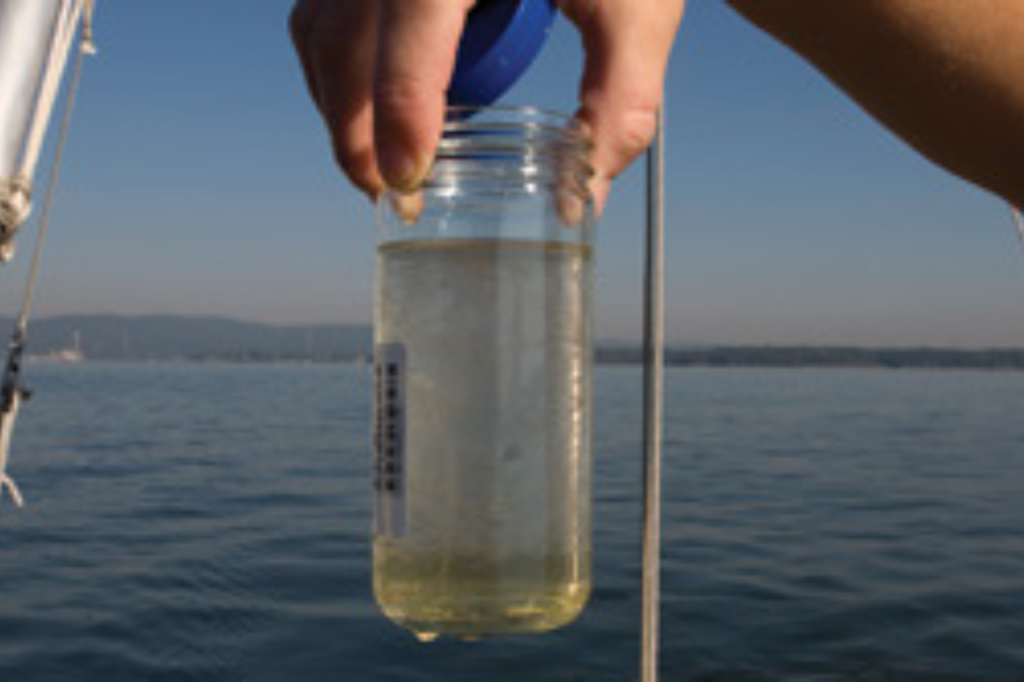
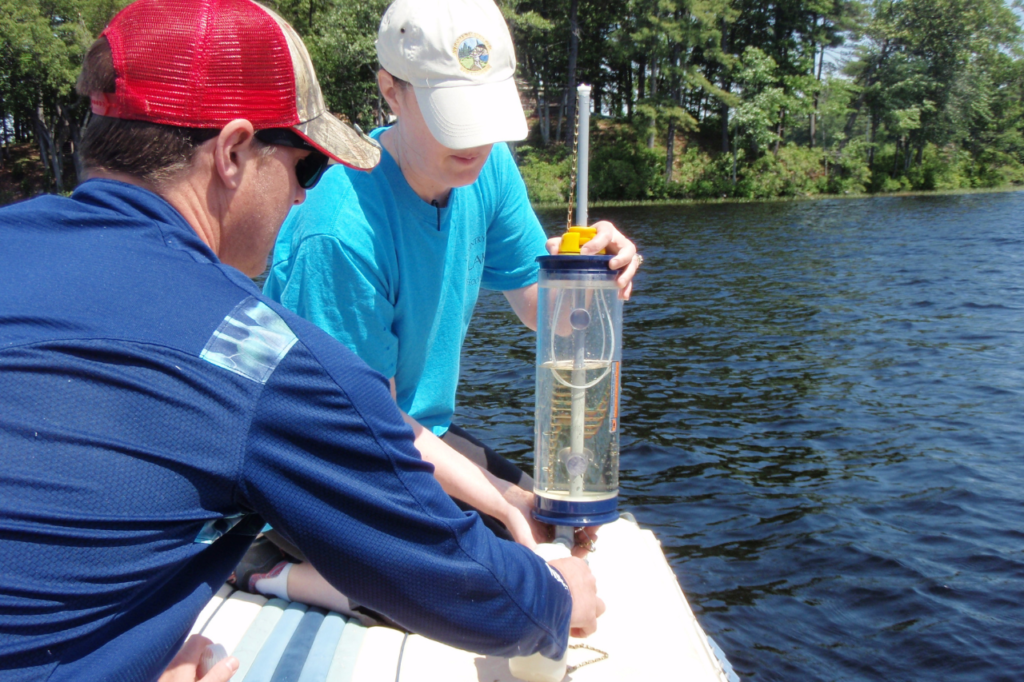
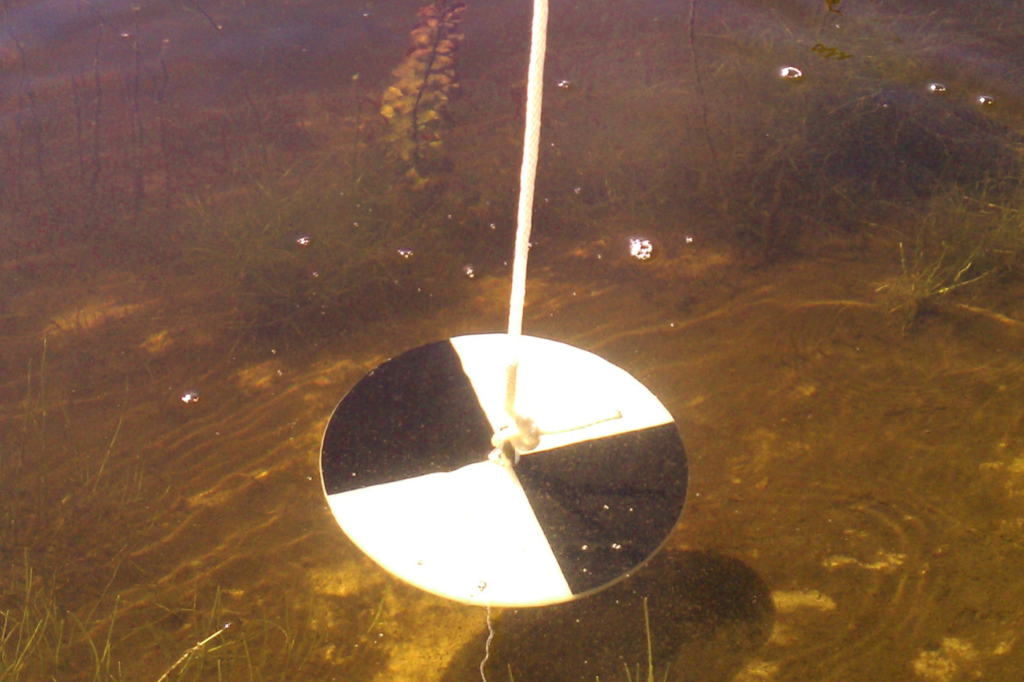
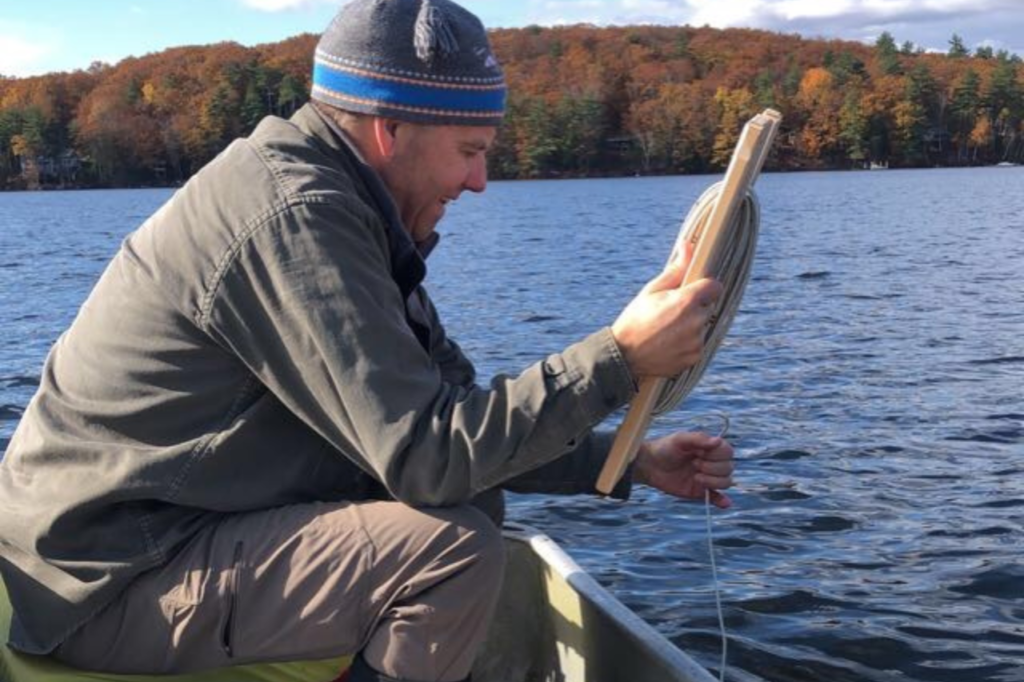
Cyanobacteria Blooms: What’s that green stuff?
Not everything green, brown or unusual in the lake is a cyanobacteria bloom. If you’d like to know for
sure what you are seeing please follow the NHDES protocol.
Healthy Swimming Mapper: find current advisories and alerts for cyanobacteria during the swim season.
Statewide Cyanobacteria Update: Join the N.H. Department of Environmental Services Email Mailing List
PPT of the Water Quality Trends data
Download the PPT slides by clicking the button below or navigate through the image slides to the left.
Clicking button will initiate a download of the Water Quality Trends PPT

You Can Help Protect Mirror Lake
Protect the lake you love! MLPA is not a homeowners’ association. All are welcome.
